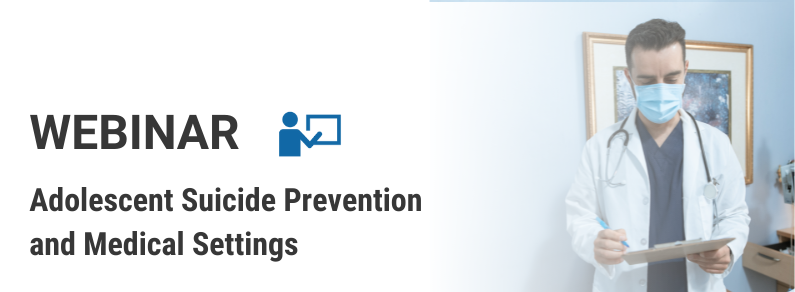 Adolescent Suicide Prevention and Medical Settings
Adolescent Suicide Prevention and Medical Settings
According to the Centers for Disease Control and Prevention, suicide is now the second leading cause of death among youth ages 10 to 24,1 with the fastest-growing rates among youth ages 10 to 14.2 There is significant racial disparity, with suicide rates among Black youth ages 13 and younger twice that for White youth.3 According to 2019 Youth Risk Behavior Surveillance System (YRBSS) data, nearly 20% of students (grades 9 to 12) reported seriously considering suicide in the prior year.4
Youth at risk for suicide are often seen by health care providers in the weeks and months prior to their deaths, indicating that there are opportunities to intervene.5 For example, approximately 80% of youth who died by suicide had visited a health care provider in the year before their death, and 40% had had a general primary care visit.6 In addition to primary care, emergency departments and inpatient facilities are critical settings for suicide prevention, as the rates of emergency department visits and inpatient hospitalizations for suicidal ideation and suicide attempts doubled between 2007 and 2015.7, 8
Medical settings can therefore play an important role in reducing youth suicide. Pediatric primary care, emergency departments, and other medical inpatient units can be critical settings to identify and care for youth at risk of suicide. Physicians and other staff are well suited to conduct routine screening and risk assessments and adopt robust clinical care pathways that can better care for and protect youth. Since many systems do not universally screen for suicide risk and individuals are unlikely to disclose suicide risk when not asked directly, youth who are at risk may be undetected despite receiving care, and that care is unlikely to include suicide-specific interventions.9
Zero Suicide provides a systems-level framework for improving suicide care across settings. Zero Suicide can be leveraged to embed standardized risk identification and development of clear clinical care pathways, as well as suicide-specific treatment and critical follow-up practices. In this webinar, presenters will discuss effective suicide prevention practices applicable to medical settings, the role of clinical care pathways and workflows that provide guidance and support for health system staff, and ways to leverage the Collaborative Care Model to connect primary and mental health care for adolescents at risk for suicide.
References:
- Centers for Disease Control and Prevention, National Center for Injury Prevention and Control. Web-based Injury Statistics Query and Reporting System (WISQARS) [online]. (May 2021). Retrieved from www.cdc.gov/injury/wisqars
- Horowitz, L., Tipton, M. V., & Pao, M. (2020). Primary and Secondary Prevention of Youth Suicide. Pediatrics, 145(Suppl 2), S195–S203.
- Bridge, J. A., Horowitz, L. M., Fontanella, C. A., Sheftall, A. H., Greenhouse, J., Kelleher, K. J., & Campo, J. V. (2018). Age-related racial disparity in suicide rates among US youths from 2001 through 2015. JAMA pediatrics, 172(7), 697-699.
- Ivey-Stephenson AZ, Demissie Z, Crosby AE, et al. Suicidal Ideation and Behaviors Among High School Students — Youth Risk Behavior Survey, United States, 2019. MMWR Suppl 2020;69(Suppl-1):47–55. DOI: http://dx.doi.org/10.15585/mmwr.su6901a6
- Fontanella, C. A., Warner, L. A., Steelesmith, D., Bridge, J. A., Sweeney, H. A., & Campo, J. V. (2020). Clinical profiles and health services patterns of Medicaid-enrolled youths who died by suicide. JAMA pediatrics, 174(5), 470-477.
- Ahmedani, B. K., Simon, G. E., Stewart, C., Beck, A., Waitzfelder, B. E., Rossom, R., … & Solberg, L. I. (2014). Health care contacts in the year before suicide death. Journal of general internal medicine, 29(6), 870-877.
- Burstein, B., Agostino, H., & Greenfield, B. (2019). Suicidal attempts and ideation among children and adolescents in US emergency departments, 2007-2015. JAMA pediatrics, 173(6), 598-600.
- Plemmons, G., Hall, M., Doupnik, S., Gay, J., Brown, C., Browning, W., … & Williams, D. (2018). Hospitalization for suicide ideation or attempt: 2008–2015. Pediatrics, 141(6).
- Horowitz, L. M., Roaten, K., Pao, M., & Bridge, J. A. (2020). Suicide prevention in medical settings: The case for universal screening. General Hospital Psychiatry, 63, 7-8. https://doi.org/10.1016/j.genhosppsych.2018.11.009
